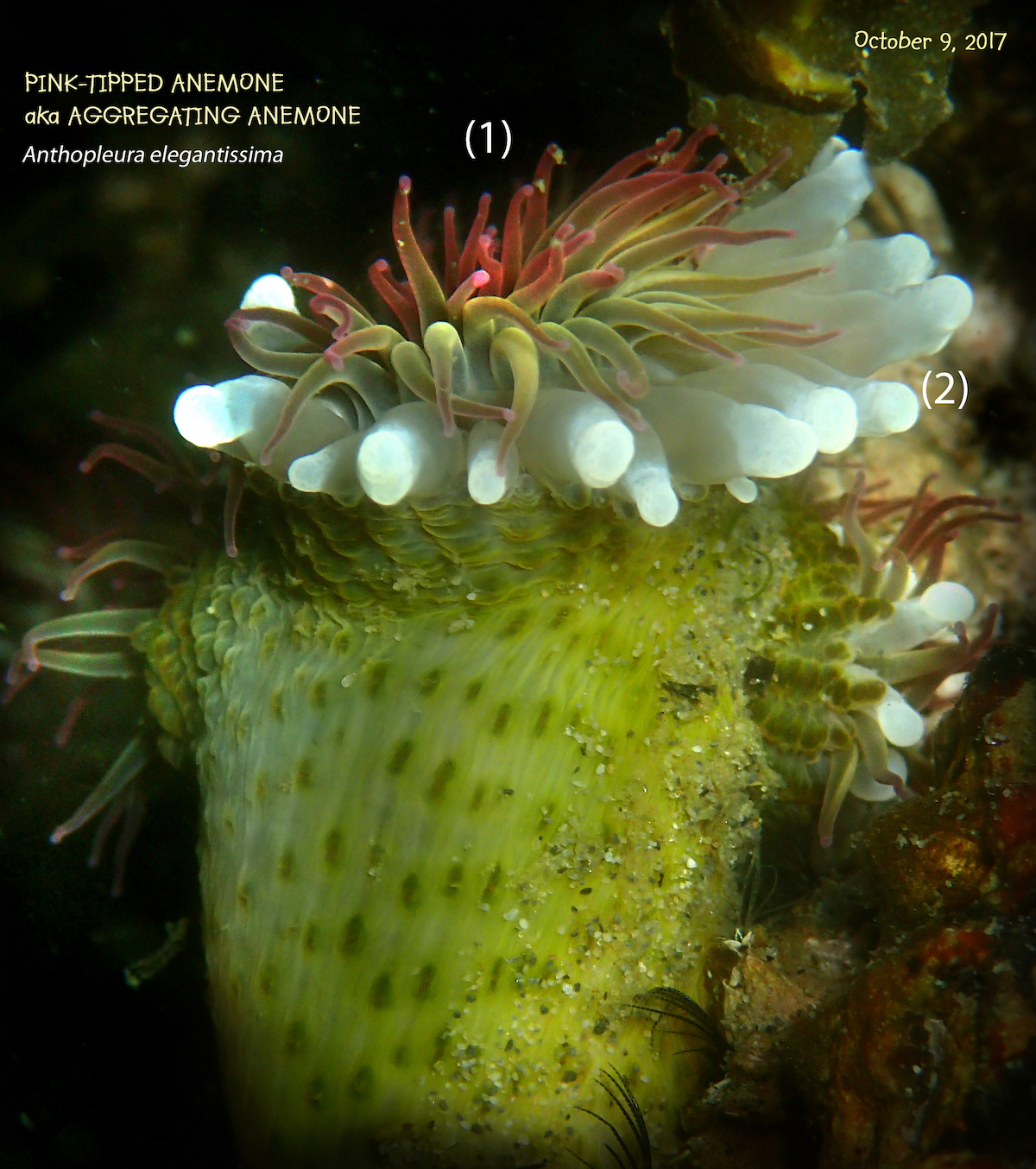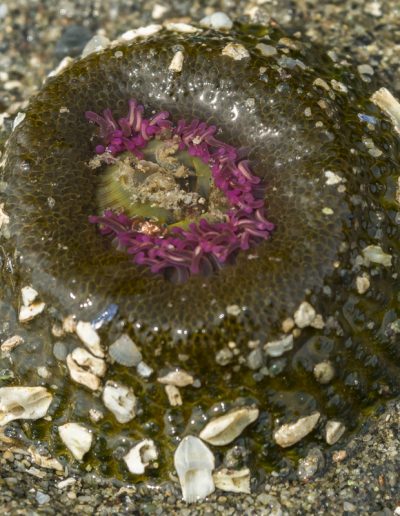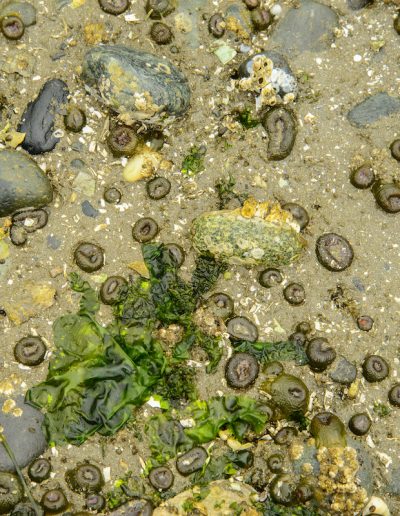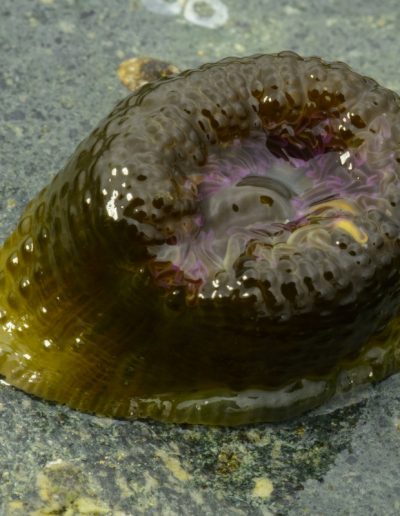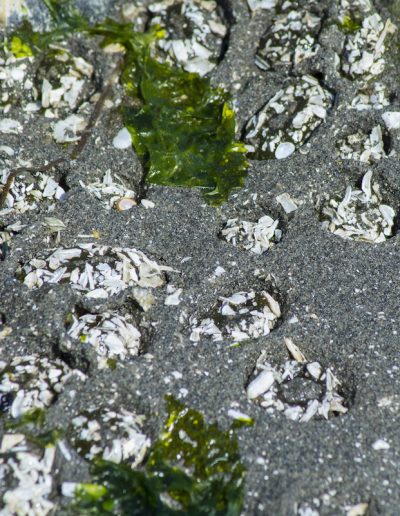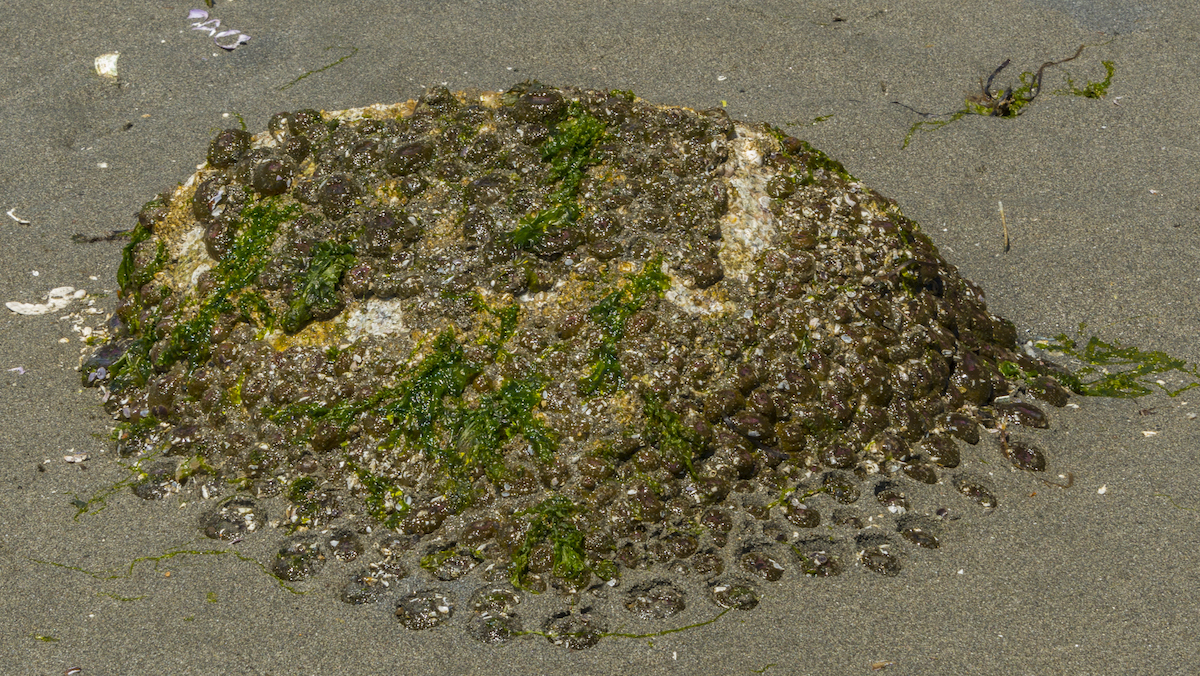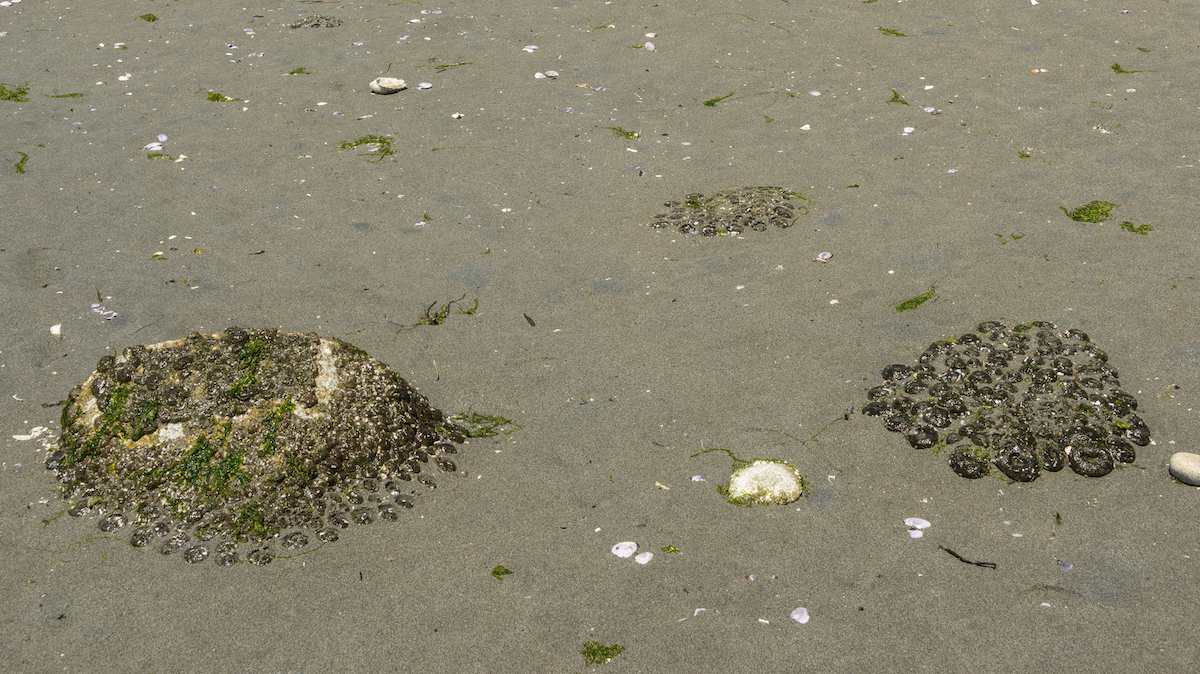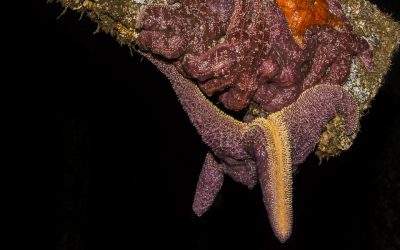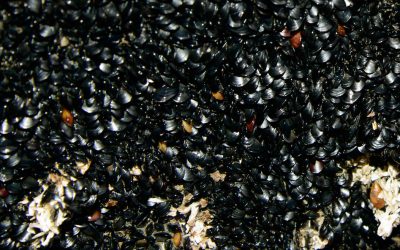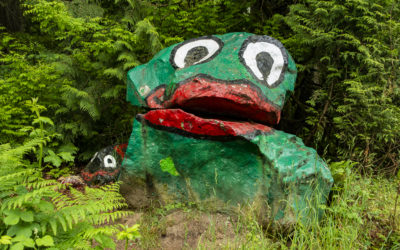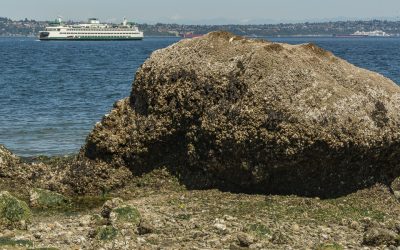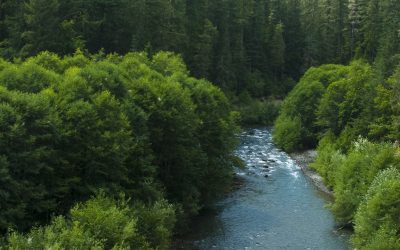Flower of the Tide Pool
Plant or Animal?By Briana Sandoval Sharon Pegany
Photos & video by John F. Williams except where noted
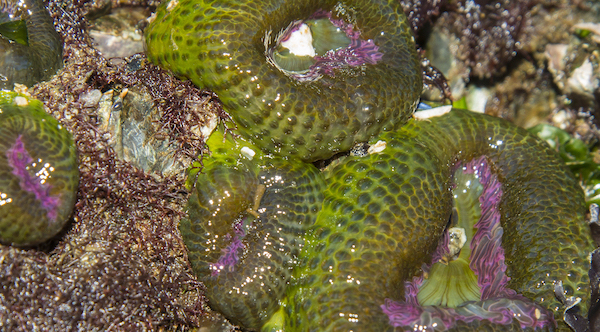
Star Eat Star World
Plant or Animal?
By Paul Pegany, Summer 2019
Photos & video by John F. Williams except where noted
Aggregating anemones are commonly found at low tide around the Salish Sea, particularly in areas with hard surfaces, such as large rocks or abandoned structures.
Audio version
It’s a warm, late summer afternoon and the tide is low. Shoreline boulders, tide pools and dripping piers are quilted with dark sea green splotches glistening with slime. Unlike any known land species, are these peculiar globs a type of marine plant or fungus? Are they mysterious creatures of the sea? Or better yet…are they some curious combination of both plant and animal?
At first glance, this low tide phenomenon could be a marine version of sprawling ground cover. But with a little investigating, it is easy to identify this creature as the aggregated anemone (Anthopleura elegantissima), a common tide pool animal found plastered along the tidal shores throughout the Salish Sea.
Unlike most other local anemones, you don’t have to wait for extremely low tides to find them. If the beach is a suitable habitat, they might be found near the zero tide height, or even somewhat higher than that.
Early in life, anemones anchor themselves to a firm substrate by secreting adhesive proteins, similar to the glue of a barnacle. Although they can move in some circumstances, anemones typically spend their lives in one place enjoying the company of their own kind.
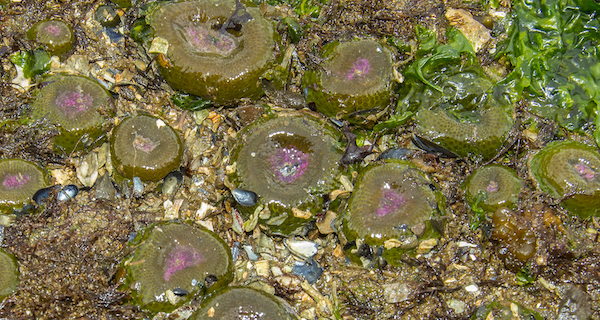
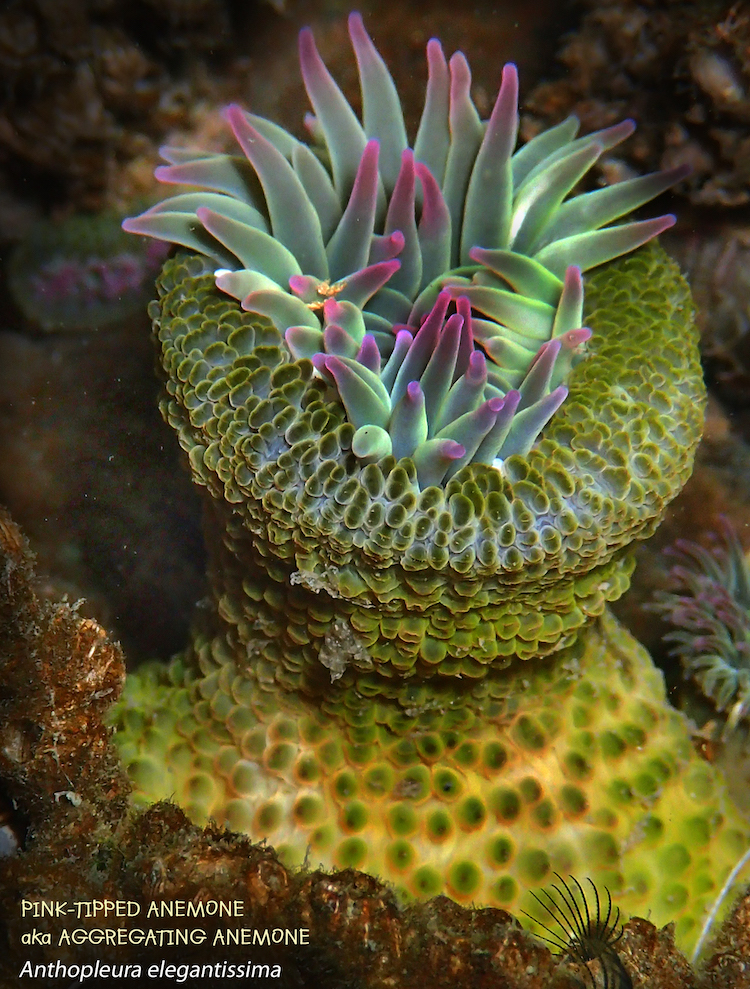
photo by Jan Kocian
living in harmony
With showy fuchsia-tipped appendages and hypnotic hues of purple and green, this species of anemone appears as an aquatic version of a chrysanthemum. In a truly remarkable symbiotic relationship between plant and animal, the anemone acts as a welcoming host to marine algae, which lives inside its body. Like all true relationships, each member contributes to as well as benefits from the other. In this case, the brightly colored algae clothe the anemone with vibrant color, so that colonies of anemones are often different colors. The algae also provide nutrients and oxygen created in the process of photosynthesis. In turn, the anemone offers the algae protection and can adjust position slightly to maximize sunlight exposure throughout the day, aiding the algae with food production.
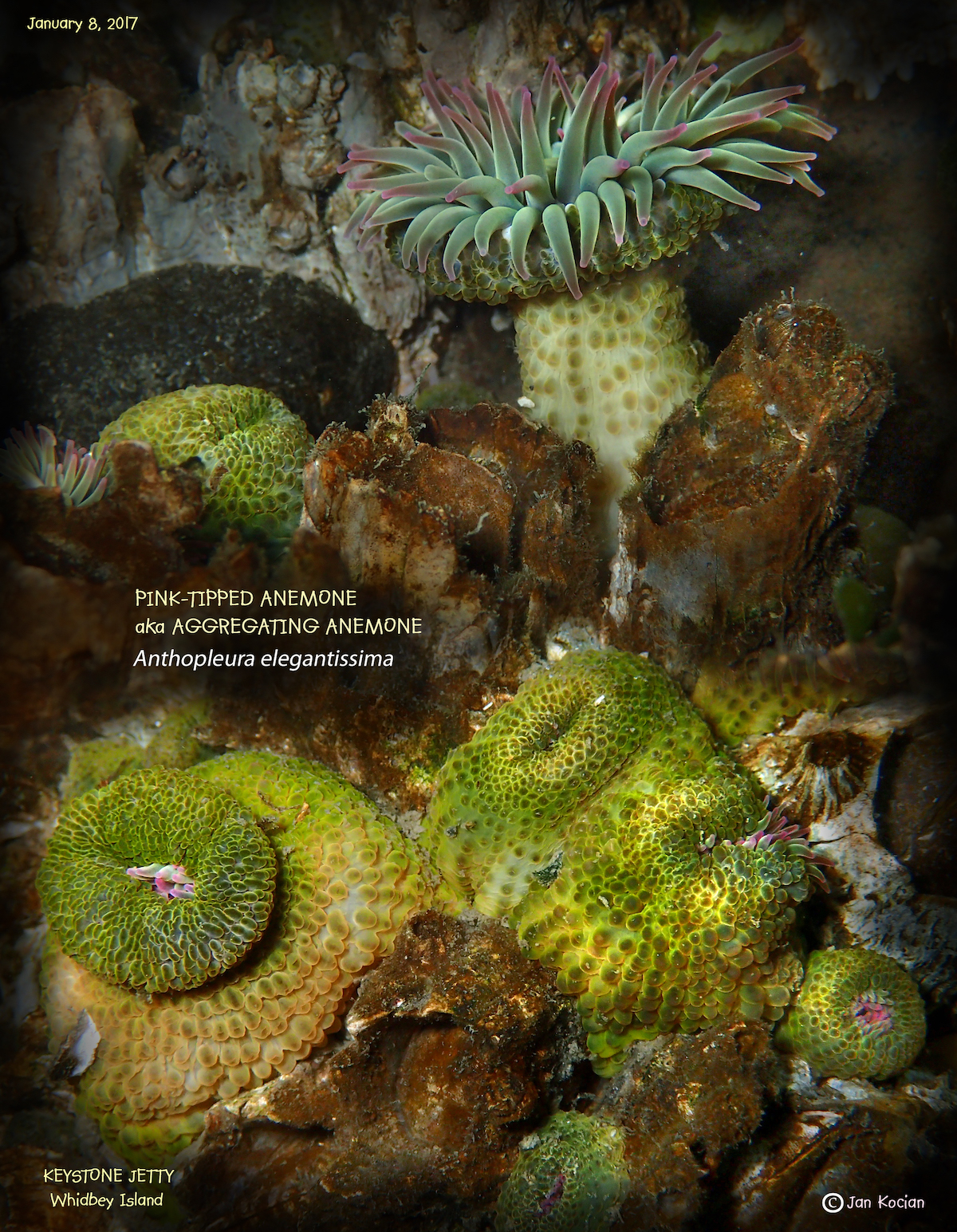
photo by Jan Kocian
living as a predator
Such an unusual creature inspires us to wonder how it sustains itself, especially since it spends most of its life anchored in one place. Aggregating anemones often live in orderly colonies, each member graced with rows of beautiful appendages that sway and lift in the current. But don’t be fooled by their delicate appearance. These appendages are actually two different kinds of tentacles, each designed for a deadly mission: to sting and poison. Rows of slender feeding tentacles circle the central oral disc while thicker, blunt-tipped fighting tentacles form a ring around the outer perimeter. Both kinds of tentacles have specialized stinging cells, but they are used for different purposes.
The delicate feeding tentacles literally snag, sting and move drifting plankton, small crustaceans, aquatic insects, and floating debris into the asnemone’s center oral disc. Each tentacle is equipped with some of nature’s fastest mechanical responses: thousands of tiny harpoon-like structures which are triggered and released in a fraction of a millisecond. They inject a toxin that paralyzes the clueless victim.
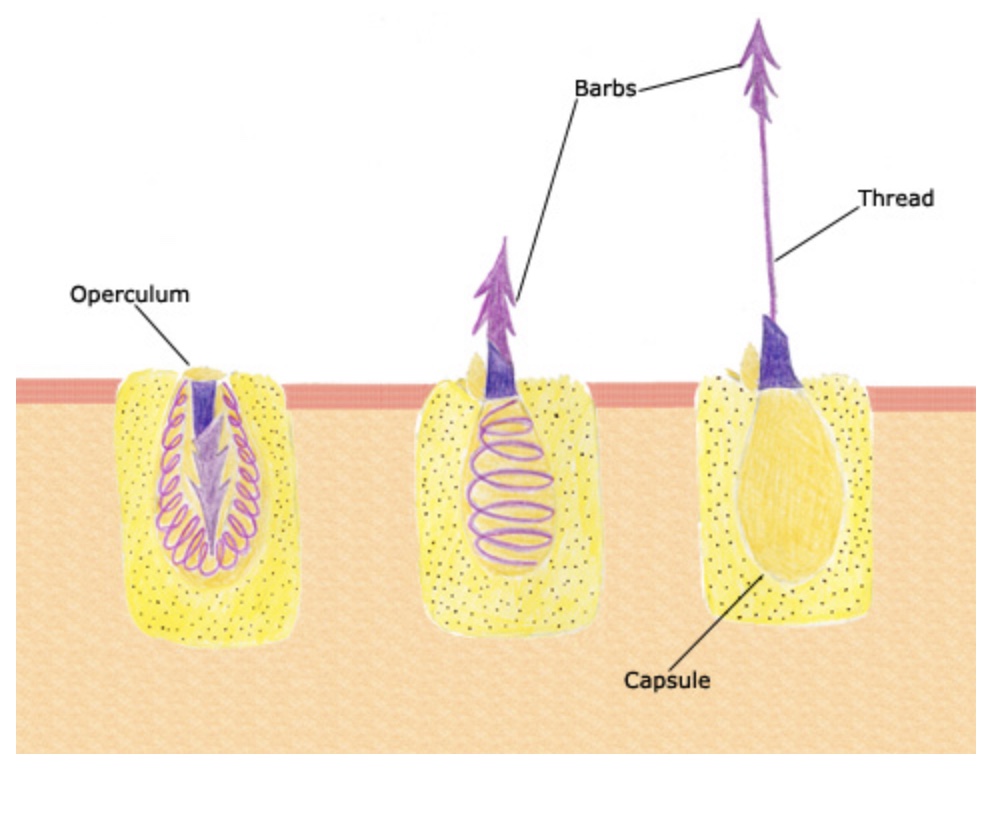
Courtesy of NOAA National Ocean Service
Harmless to humans, we too can experience the sticky barbs by touching the underside of the tentacles with a gentle one or two finger touch. Imagine being the size of a small ocean creature caught in such a beguiling trap.
Excerpt from “Exploring at Low Tide”. See citation below under “Find Out More”.
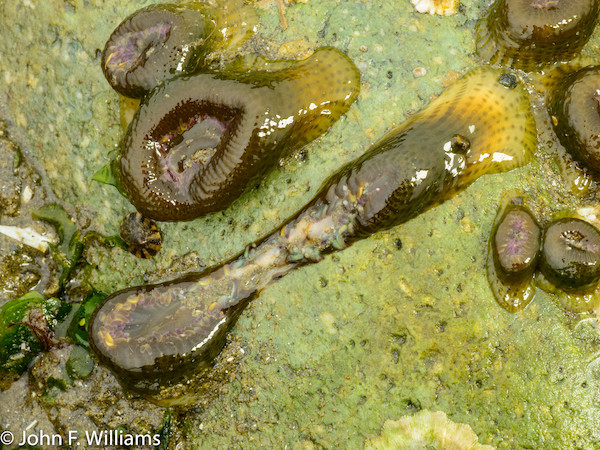
making more anemones
Like many marine animals, aggregating anemones can reproduce sexually by releasing eggs and sperm into the water, which can produce anemones that eventually latch onto a substrate. But a far more intriguing storyline lies in their ability to clone themselves with precise genetic duplication. As a single anemone reaches maturity, it can split in half, undergoing a fascinating process in which it stretches in opposing directions until two well-formed anemones appear where there was once just one. Individuals repeat the budding process, resulting in a tight colony of identical clones.
competing for space
ach anemone is an individual animal, but the colony also operates with admirable interdependence. Like a well-organized army, each member of the colony has a vital role to play in the survival of the whole. Reproductive anemones can be found in the center of the group, surrounded by larger warrior anemones with powerful stinging cells. Smaller scout anemones line the perimeter and are willing to die for the survival of the rest.
All members of the colony are genetically identical, united by common DNA, and have no interest in mingling with outsiders. But the plot thickens as the colony begins to expand into surrounding territory. Aggregating anemones are capable of sensing members of a foreign colony encroaching on their space and will use their powerful fighting tentacles to push them back.
When two colonies grow too close, anemones of each colony contract and manipulate water pressure to catapult toxic harpoon-like structures filled with painful stinging cells into the other colony. Members up to four rows away from the invaders can rear up and stretch over the outliers to launch their weapons. If one colony is overwhelmed or outnumbered, it will recede. Or when the tide exposes the anemones, a truce is reached, at least until the next high tide.
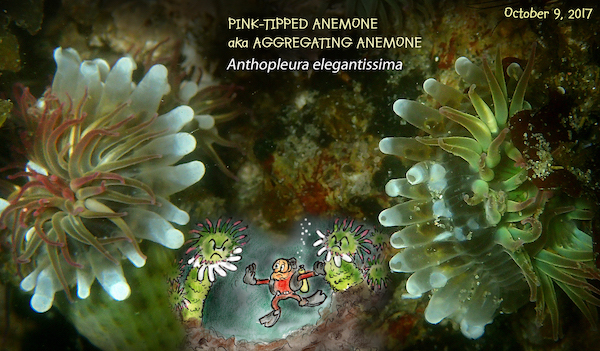
photo/art by Jan Kocian
then the tide goes out
It is hard to imagine such a dramatic battle scene when observing the colonies at low tide, a quiet time when many sea creatures seek shelter from the harsh, dry conditions. The once valiant anemones curl their tentacles inward and allow their sturdy greenish-gray, exterior column to envelop the fragile inner structures, protecting them from exposure to the elements as well as from predators. They no longer resemble flowers or warriors, but are transformed into gloppy dull colored lumps covered with bits of broken shell and other tidal debris. It is easy to miss them as they blend into the beach environment.
The intertidal zone is also home to a number of animals that prey on the soft-bodied anemone. Sea stars will consume an anemone if the anemone is unable to pull up anchor and escape. Other predators such as the sea slug will consume anemones beginning with the lower column, while sea snails prefer to attack only the tips of the tentacles.
Clustered in the shadows of a quiet pool, anemones are without a doubt one of the most stunning inhabitants of the intertidal zone. Colonies of aggregating anemone are fun and easy to find throughout the Salish Sea, but be sure to watch your step as you explore sandy stretches and large rocks at low tide. When you find them, use wet seawater dipped hands to gently feel their cold, smooth exterior column, without touching the fragile center. Notice immediate deflation followed by a squirt or trickle of water expelled from the slightly bloated anemone. Look for evidence of predation or battle scars as you examine colonial patches. Above all, enjoy a fleeting glimpse into a dynamic world so different, yet in some ways similar, to your own.
At first glance, these anemones appear to be just popping out of the sand. How can that be? The second and third photos show that the rock they are attached to is just covered with sand. Click on image to make the photos bigger.
see them yourself
Aggregating anemones can be viewed at many locations around the Salish Sea, particularly in areas with hard surfaces and high mussel presence. This species is frequently seen attached to large rocks and boulders as well as other firm substrates.
The map in this issue shows a few places where you are likely to find some of the things mentioned in these articles.
POETRY
Flower of the Tidepool
by Briana Sandoval
Tentacles long; and bold, and pink
“The flower of the tide pool” as one may think
All at once, recedes the tides,
Nothing seen but pink green eyes
Anemone, anemone; are you looking at me?
Do your eyes desire, this heart that beats?
Water levels rise, you no longer hide!
Angel hair flows, with tides do glide.
Shells of crab and seashell jewels,
You watch and guard, you are no fool.
All at once, recedes the tides,
Nothing seen but pink green eyes.
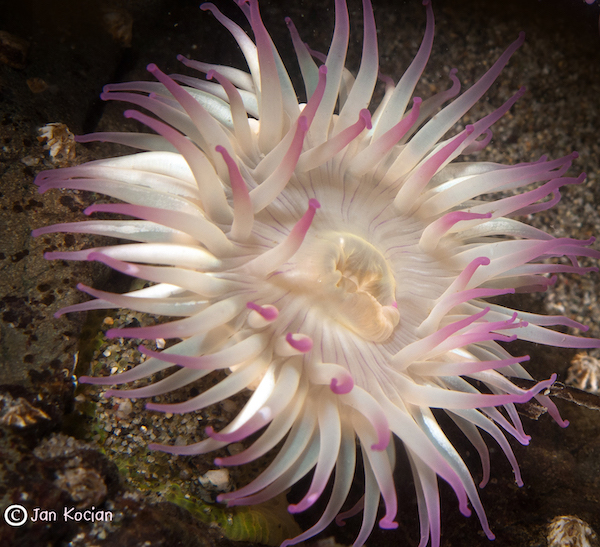
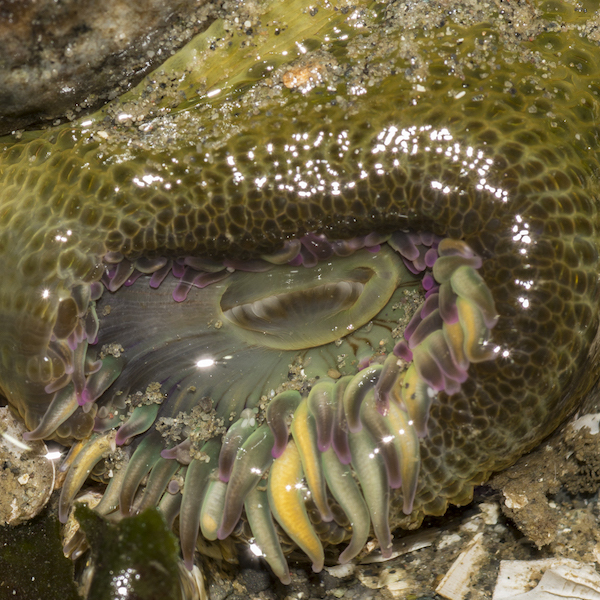
Table of Contents, Issue #1, Autumn 2018
Seeing Stars?
By Jeanne Wright, Nancy Sefton Photos & video by John F. Williams except where notedA Struggling Keystone Species By Jeanne Wright, Nancy Sefton, Autumn 2018 Photos & video by John F. Williams except where notedcommon in the salish sea Several kinds of...
Mussel Strength
How Mussels Serve Our Ecosystem By Jill Needham, Kathleen Alcalá Photos & video by John F. Williams except where notedHow Mussels Serve Our Ecosystem By Jill Needham, Kathleen Alcalá, Autumn 2018 Photos & video by John F. Williams except where notedcommon in...
Big Boulders
By Greg Geehan, John F. Williams Photos & video by John F. Williams except where notedA Place to Attach By Greg Geehan, John F. Williams, Autumn 2018 Photos & video by John F. Williams except where notedMuch of the sand and gravel on Salish Sea beaches comes...
The Barnacle
By Tasha Smith, Leigh Calvez, Deb Rudnick Photos & video by John F. Williams except where notedMore Than Meets the Eye By Tasha Smith, Leigh Calvez, Deb Rudnick, Autumn 2018 Photos & video by John F. Williams except where notedMy first experience with...
Postscript-1
By John F. Williams Photos & video by John F. Williams except where notedVisualizing an Ecosystem By John F. Williams Photos & video by John F. Williams except where notedTelling the story of a system as complex as the ecosystem we live in is a tall order....
FIND OUT MORE
There is a lot of information about aggregating anemones online, but here are a few resources that are fun, informative and relevant to this article.
Cardone, B. J. (2016, August 15). “Simple, But Complicated: All About Aggregating Anemones”. Retrieved from: cadivingnews.com/simple-complicated-aggregating-anemones/
Jan Kocian combines photography with drawing to produce insightful and informative glimpses of marine life. https://jankocian.smugmug.com/Fauna-Flora
NOAA National Ocean Service, Communications and Education Division, Corals Tutorial: https://oceanservice.noaa.gov/education/kits/corals/media/supp_coral01b.html
Rogers, A. (2014). MICA: Maryland Institute College of Art. Retrieved from https://www.mica.edu/Browse_Art/Anatomy_of_Sea_Anemone_by_Addie_Rodgers.html
“SEA ANEMONE: FOODS EATEN”. (n.d.). Retrieved 2018, from http://www.asnailsodyssey.com/LEARNABOUT/ANEMONE/anemFood.php
Slater Museum of Natural History. Aggregating Anemone. Retrieved from https://www.pugetsound.edu/academics/academic-resources/slater-museum/exhibits/marine-panel/aggregating-anemone/
wallawalla.edu. “Anthopleura elegantissima (Brandt, 1835)” Retreived from: https://inverts.wallawalla.edu/Cnidaria/Class-Anthozoa/Subclass_Zoantharia/Order_Actiniaria/Anthopleura_elegantissima.html
WSU Extension and Still Hope Productions (2014). “Exploring at Low Tide” The video clip discussing anemones stinging was from this movie.

